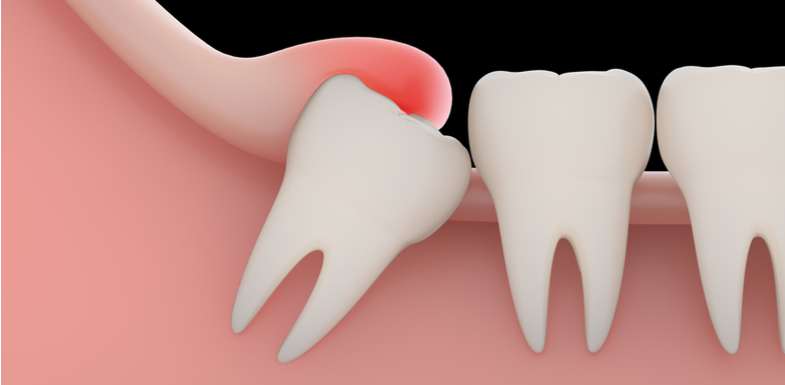Erupting wisdom teeth are a part of life as a teenager or young adult, but this normal rite of passage can come with some challenging complications. Smaller jaws and less need for a third set of molars can result in gum tissue that just does not want to give way. While most people overcome this without any intervention, for some, a dental operculum can quickly turn painful. Here’s what you should know.
What is an operculum?
An operculum is an extra flap of gum tissue (gingiva) that covers part of the chewing surface of a tooth. This common dental condition is found mostly in teenagers and young adults and mostly in relation to the wisdom teeth as they erupt.
In the majority of cases, as the wisdom teeth erupt, the operculum moves away and recedes as the tooth comes in. However, when there is insufficient room for a tooth to emerge, the operculum will continue to partially cover the tooth.
If this happens, various complications can occur. Cheek biting is the most common complication, as the operculum is close to the cheek. Tooth decay can also occur as a result of bacteria trapped beneath the dental operculum. The most serious of these complications is pericoronitis.
What are pericoronitis complications?
Pericoronitis (also known as operculitis) is an infection near the third wisdom tooth that arises when the dental operculum becomes inflamed.
Common symptoms of acute pericoronitis include:
- Pain near the wisdom teeth
- Swollen gums
- Pain when swallowing (not located in the throat itself)
- Swollen lymph nodes
- Loss of appetite
- Pus in the area of infection
- Feeling unwell
- Trismus (lockjaw)
If the infection is chronic, you may also experience:
- Chronic bad breath
- A bad taste in the mouth
- The ongoing reoccurrence of a mild ache that lasts a day or two before subsiding
Age is a risk factor for pericoronitis, as is poor oral hygiene, impacted wisdom teeth, and the presence of dental operculum (excessive gum tissue). While not actually related to wisdom teeth extraction, the period leading up to the extraction is a vulnerable one, especially if other risk factors are present.
Lockjaw is one of the most serious complications of pericoronitis, but another rare and life-threatening complication is Ludwig’s angina. This occurs when an infection from the dental operculum spreads into the head and neck. Sepsis, a condition where the infection spreads to the bloodstream, is also a rare but life-threatening complication.
How long does pericoronitis last?
Pericoronitis lasts until treatment is implemented. Once an infection begins in the body, it is an exceptional person who heals without some form of medical intervention.
If you have minor signs of pain and discomfort, at-home interventions like stepping up oral hygiene practices and rinsing regularly with salt water can help prevent further infection and reduce symptoms.
If the wisdom tooth does not completely erupt during this phase or soon after, additional operculum treatment may be necessary.
How to treat an operculum
If you are experiencing the beginning symptoms of pericoronitis, the treatment of a dental operculum consists of three phases, including:
- Managing pain and treating infection
- Removal of the operculum
- Wisdom teeth extraction
Managing pain and treating infection
Pain management of a dental operculum focuses on over-the-counter non-steroidal anti-inflammatory drugs (NSAIDs) such as ibuprofen or naproxen.
If there are bacteria trapped underneath the operculum (and it is not yet time to remove the operculum), your dentist will thoroughly clean the area. This procedure requires local anesthesia for patient comfort. Your dentist may also prescribe an oral rinse containing chlorhexidine to keep that area clean.
If inflammation is present and infection is suspected, your dentist may also prescribe a course of antibiotics. Follow all directions for their use exactly.
Removal of the operculum
If the wisdom teeth appear to be impacted, with the operculum as a primary cause, your dentist may opt to perform an operculectomy. This is a minor oral surgery that removes the extra flap of skin.
Your dentist will use X-rays and their own clinical experience to determine if this intervention is needed or if better oral hygiene and a wait-and-see approach is better.
Unfortunately, if the wisdom tooth with the gum overgrowth does not erupt soon after the operculectomy, the operculum may grow back, requiring a second surgery.
Wisdom teeth extraction
When all else fails, wisdom tooth extraction may be the only thing that completely treats pericoronitis. For most people who get to this point, a surgical tooth extraction is their only option (as opposed to a simple extraction).
This procedure is routine but does require local anesthesia. If you feel nervous or concerned about pain, your doctor may prescribe a mild sedative to take before the procedure. In some cases, IV sedation is an option that can make you more comfortable.
Once your gums are numb, your dentist will make an incision in the gum to release the tooth. This may be from the top where the operculum is or from the side of the gum (or both if necessary). Depending on what your X-rays show, your dentist may be able to remove the tooth in one piece. In other cases, the tooth is safely removed in pieces.
From there, your dentist will then rinse the extraction site thoroughly, checking to make sure the whole tooth has been removed, before closing the wound with dental sutures.
While this seems a complicated procedure, your wound should be completely healed within 30 days. Taking good care of your incision (including being careful with the clot) and following your dentist’s post-operative instructions carefully can help speed along your healing.
In cases where a dental operculum means trouble, AZ Dentist is here for you. We are your Phoenix area weekend dentist. Get in touch today!
